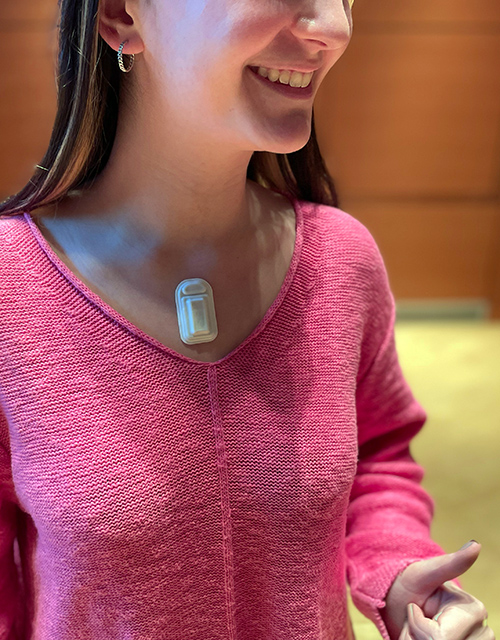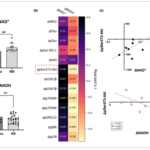歌手、政治家、教師、コーチが新しいスマートテクノロジーの恩恵を受ける可能性 Singers, politicians, teachers, coaches could benefit from new smart technology
2023-02-20 ノースウェスタン大学

Bienen student Madeleine Zuckerman wears the device in Brancaccio’s opera class.
◆この世界初の電池式ワイヤレス機器とそれに付随するアルゴリズムは、プロの歌手、教師、政治家、コールセンター職員、コーチなど、声を使って効果的にコミュニケーションをとり、生計を立てている人々にとって画期的なものになる可能性があります。また、臨床医が音声障害を持つ患者を治療中、遠隔で継続的にモニターするのにも役立つと考えられます。
◆この新技術は、材料科学者、生物医学エンジニア、オペラ歌手、言語病理学者からなる学際的なチームによって開発され、2月20日の週に米国科学アカデミー紀要に掲載される予定です。
◆このソフトで柔軟な切手サイズのデバイスは、胸の上部に心地よく密着し、会話や歌に伴う微妙な振動を感知することができます。撮影されたデータはBluetooth経由でユーザーのスマートフォンやタブレットに瞬時にストリーミングされ、ユーザーは1日中リアルタイムで自分の発声活動をモニターし、累計の発声使用量を測定することができます。機械学習アルゴリズムにより、発声と歌唱の違いを識別し、それぞれの活動を個別に記録することができます。
◆このアプリでは、ユーザーは自分専用の発声閾値を設定することができます。その閾値に近づくと、スマートフォンやスマートウォッチ、あるいは手首に装着した付属のデバイスが、アラートとしてリアルタイムの触覚フィードバックを提供します。そして、無理をする前に声を休ませることができます。
<関連情報>
- https://news.northwestern.edu/stories/2023/02/first-wearable-device-for-vocal-fatigue-senses-when-your-voice-needs-a-break/
- https://www.pnas.org/doi/10.1073/pnas.2219394120
発声疲労の定量化とユーザーフィードバックのための皮膚接触型ワイヤレスデバイスの閉ループネットワーク Closed-loop network of skin-interfaced wireless devices for quantifying vocal fatigue and providing user feedback
Hyoyoung Jeong,Jae-Young Yoo,Wei Ouyang,Aurora Lee Jean Xue Greane,Alexandra Jane Wiebe,Ivy Huang,Young Joong Lee,Jong Yoon Lee ,Joohee Kim,Xinchen Ni,Suyeon Kim,Huong Le-Thien Huynh,Isabel Zhong,Yu Xuan Chin,Jianyu Gu,Aaron M. Johnson,Theresa Brancaccio,John A. Rogers
Proceedings of the National Academy of Sciences Published:February 21, 2023
DOI:https://doi.org/10.1073/pnas.2219394120
Significance
The absence of a quantitative monitoring method that can assess the health status of vocal folds increases the potential risk of incurring a vocal disorder. A closed-loop network system that combines a skin-interfaced wireless sensor technology and a haptic feedback module enables continuous monitoring of vocal fold activities related to vocal fatigue. Data analysis using real-time machine learning techniques separates and quantifies vocal dosimetry associated with speaking and singing, without confounding artifacts from ambient sounds, along with a breadth of information on cardiac and respiratory activities and overall physical exertion. This technology approach can help to guide healthy behaviors in vocal usage across a range of affected populations, from singers and teachers to coaches and telemarketers.
Abstract
Vocal fatigue is a measurable form of performance fatigue resulting from overuse of the voice and is characterized by negative vocal adaptation. Vocal dose refers to cumulative exposure of the vocal fold tissue to vibration. Professionals with high vocal demands, such as singers and teachers, are especially prone to vocal fatigue. Failure to adjust habits can lead to compensatory lapses in vocal technique and an increased risk of vocal fold injury. Quantifying and recording vocal dose to inform individuals about potential overuse is an important step toward mitigating vocal fatigue. Previous work establishes vocal dosimetry methods, that is, processes to quantify vocal fold vibration dose but with bulky, wired devices that are not amenable to continuous use during natural daily activities; these previously reported systems also provide limited mechanisms for real-time user feedback. This study introduces a soft, wireless, skin-conformal technology that gently mounts on the upper chest to capture vibratory responses associated with vocalization in a manner that is immune to ambient noises. Pairing with a separate, wirelessly linked device supports haptic feedback to the user based on quantitative thresholds in vocal usage. A machine learning-based approach enables precise vocal dosimetry from the recorded data, to support personalized, real-time quantitation and feedback. These systems have strong potential to guide healthy behaviors in vocal use.


